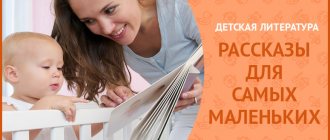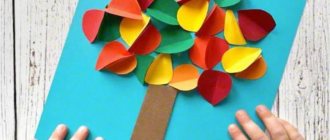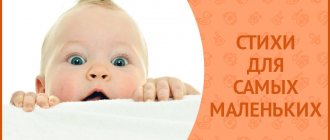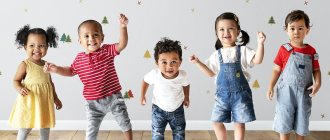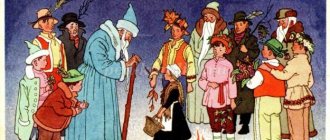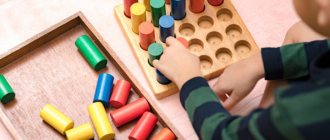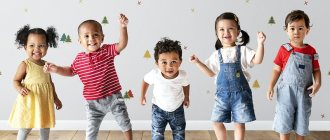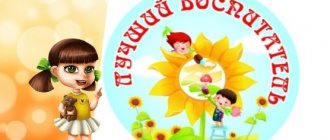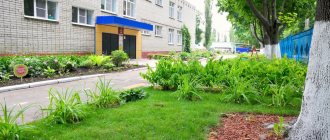Features of child development at 2 years old
At this age, the baby enjoys exploring the world around him, he wants to touch everything, taste it, and see what is inside. He already has good control over his body and can do some things on his own.
Physical development:
- the child learned to coordinate movements;
- large and fine motor skills are sufficiently developed;
- the movements are correct.
Self-care skills:
- eats and drinks himself;
- goes to the toilet and washes himself, washes his hands;
- can take off and put on clothes without assistance.
Intellectual development:
- vocabulary is actively replenished;
- enjoys communicating with other children and adults;
- feels a high need to study the world around him;
- drawing, dancing, music, singing.
What to do with your child for physical development
The simplest and most effective activity you can offer your child is all kinds of ball games. You can start by simply throwing a ball into the child’s hands, especially since this game is also suitable for a small apartment. During the lesson, grasping movements and the ability to quickly and accurately calculate each action are developed.
Another version of the game: sit on the floor opposite each other, spread your legs wide so that it looks like a goal. By rolling the ball back and forth along a certain trajectory, the child will learn to concentrate on his actions.
Another interesting ball game, of course, is edible-inedible. It is not only funny and liked by all kids without exception, but also perfectly develops reaction, because you need to quickly figure out whether the named item can be eaten or not, and make the right decision.
What else can you do with the ball?
- play football with alternating legs;
- throw it up;
- try to throw into the basket;
Overcoming all sorts of obstacles is also useful for physical development: for example, practicing on the wall bars, balance beam, and horizontal bar. Young children do not have a strong sense of danger, so they should exercise on sports equipment only under the supervision of their parents.
Sensorimotor activities - all the fun
You've probably heard that the best toys for small children are not toys at all. Little ones are occupied with bolts, clothespins, pots and keyboards. Sometimes - more than bright and beautiful toys for 2-year-olds. I propose to use this trick when developing sensorimotor skills. What can be used and what causes a constant surge of energy in little researchers:
- Clothespins. Preferably ones that open easily. They can be used to carry small objects - for example, pieces of sponges for washing dishes. The same thing is done with toy tweezers.
- Winders. We take a toilet paper roll, attach a thread to it, and let’s wind it! First we study, then we improve speed. In the right atmosphere, this is usually accompanied by laughter.
- Lather. Real magic! It is better to use harmless, phosphate-free products for whipping it. Give your child a whisk or a bubble blower - fun is guaranteed! You can give out a straw, but be careful not to suck in any liquid.
- Bolts and nuts. We buy different sizes. The child’s task is to find a pair and screw it in. An option is to select lids for cosmetics jars of different diameters.
- Children's teapot and cups. We pour water.
- Pipettes. We take cups and color the water with gouache. Using a pipette, pour it into the cells. Pill boxes and various boxes divided into small compartments are suitable as cells.
- Matryoshka dolls. I have already written about them here . We collect nesting dolls and combine the design on them.
- Puzzles. You can start with 4 parts and go up to 20. Homemade puzzles also work well: take a picture and cut out pieces in different places. The child’s task is to put it in place.
And what else? Yes, a lot of things. You can do exercises and play with finger toys, use construction sets and lacing tablets, mosaics, kinetic sand, and put together pictures from cubes. Close the latches and clasps (all of this can be used to create a chic bodyboard ), dress dolls, sculpt from plasticine.
Games for intellectual development
This group includes games aimed at improving fine motor skills and sensory perception. The way a child moves his fingers and arms is interconnected with the development of important brain centers, such as the centers of speech, vision, motor coordination, and thinking. What educational activities can you organize at home?
- Coloring large pictures and drawing with paints, crayons, pencils.
- Cutting out basic shapes from cardboard with scissors.
- Modeling from salt dough, plasticine, clay. Start with koloboks and sausages and gradually move on to more complex figures.
- Various applications made from paper, magazine pictures, cardboard.
- Games with small objects: beans, colored rice (color regular cereal with food coloring for eggs), buttons, shells, mini cars.
Let your child take apart a regular dresser drawer, just make sure all the items are safe first. Another simple game is to put beans or buttons into a plastic bottle with a narrow neck.
Don't ask your child to create a masterpiece right away. Always go from the simplest to the most complex and don’t put pressure on the child if he doesn’t succeed or is tired. Be sure to explain safety rules. Help him in the first lessons, over time he will learn to perform these actions on his own. Don't be stingy with praise, even if the house you painted doesn't look like a building. Set up a home exhibition and show your creations to other family members so that your child remembers the state of success.
Where to start
Classes for 2-year-old children should begin with the development of hand motor skills. Buy blocks or construction sets and build towers and houses with your child. First, start with primitive figures; after a couple of days, the child will begin to assemble such structures on his own. Just don’t play silently, talk to your child all the time and show emotions. Say positive words and praise him.
Probably every mother notices that during this period children actively want to take part in household chores. Let them sweep on their own or give them a duster to wipe up dust. This is how you lay the initial foundation for understanding what help is. Always give your child the opportunity to help you, otherwise in the future you will have to force him to do house cleaning.
Why do you need to play in the sandbox?
The sandbox is not only a place where a child makes his first friends. For children, it is a powerful source of tactile sensations and creative opportunities that promote intellectual development.
- The construction of castles, tunnels and other structures awakens imagination.
- Baking Easter cakes and playing with molds help to better distinguish shapes and sizes.
- Interaction with other children develops communication skills and outlook.
- Fine grains of sand provide constant massage to the fingers and palms, which has a beneficial effect on the development of speech and sensory centers.
Hand coordination and motor skills
Touch is important to children. You probably noticed that at 1.5 years old the child carefully watched his hands. Now you need to learn how to control your limbs. Activities with a 2-year-old child should include playing with fingers. Learn rhymes that will turn the activity into an interesting story. Let the baby bend and straighten the corresponding fingers, learn the game “Foods”. With the help of such exercises, hand coordination develops. Touch your child's hands as often as possible. Such physical contact with parents is very important for every child.
Why is it so important to develop fine motor skills? Because when the fingers work, nerve impulses provoke the development of those parts of the brain that are responsible for the speech apparatus. This means that fine motor skills are responsible for the development of a child’s speech. In addition, this is good preparation for future penmanship classes.
“I myself!”
Allow your child to touch as many objects as possible, study their shape, size, surface quality, color, purpose. It is important for a child to accumulate as much knowledge as possible about the world around him and learn to apply it correctly. Involve your son or daughter in feasible household chores:
- sweep the floor - you can buy a small broom and dustpan;
- wash the dishes after yourself - it’s good if they are made of plastic;
- dress and undress, put clothes and toys in place;
- wash;
- wipe the table with a napkin, etc.
This will make him more independent, help him learn important self-care skills, and give you some free time.
"Kindergarten" laws
The right of a child to receive preschool education in Russia is guaranteed by the Law “On Education” (Articles 3, 10), and the basic principles of state policy in the field of education are noted:
- the right of everyone to receive education and non-discrimination; education should be free and accessible to all;
- the principle of humanism in education, taking into account the individual characteristics of all children;
- the principle of the value of human life and health, free and comprehensive development of the individual.
In domestic realities, it is advisable for young parents to study this document in detail in order to know their rights. Unfortunately, sometimes you have to defend the rights of the child and your own when communicating with representatives of the educational institution.
Why do we need a kindergarten?
Food for thought. A child spends from 3 to 8 hours in kindergarten. A three-year-old baby is under the supervision of teachers for a third of the day, and sleeps for another third. It turns out that the family and the kindergarten almost equally share responsibility for the development of the child.
The main goal of the preschool education system is the comprehensive development of the child from 0 to six or seven years of age and preparation for the next stage of education - primary school.
To do this, the temporary stay group (formerly the nursery group) and the kindergarten must by law:
- Create a comfortable environment and conditions for the timely neuropsychic and physical development of children.
- Develop speech, perception, attention, memory, thinking, imagination and emotional-volitional sphere.
Does kindergarten teach bad things? A child may “bring” swear words home from classmates, but only mom and dad are responsible for whether the child will use obscene language in the future. The culture of communication is instilled, first of all, through the family. What the child sees at home, he transmits to his peer group. Therefore, blame the kindergarten less and talk to your child more often about “good” behavior.
Depending on the age characteristics of the mental and physical development of children, groups are formed in preschool institutions. Each of them must have a teacher who knows and takes into account these features. Special educational standards and programs have been developed for each age category.
Teachers and educators are called upon not only to supervise children's games, but also to teach students communication and everyday skills. A lot in a little personality depends on the participation, opinion and culture of the teacher. It is the teacher who becomes the most significant adult, besides the mother, who influences:
- Adequacy of self-esteem;
- Social development;
- Moral and ethical ideas;
- Creative skills;
- Self-care skills;
- Study skills (perseverance, attentiveness, interest in learning).
This is not a complete list of the areas of responsibility of preschool teachers, and all this is within the framework of the law. However, you should not shift to the kindergarten those problems that can only be solved within the family.
Who is accepted into kindergartens?
Important document. You will find all the details of the answer to this question in Order of the Ministry of Education and Science of Russia dated 04/08/2014 N 293 “On approval of the Procedure for admission to training in educational programs of preschool education”
Each kindergarten is assigned certain addresses - a territory. If you and your child live with registration in this territory, then you have a priority right to secure a place in the group. If there are free places, admission is open throughout the year.
Groups of healthy children are formed by age. When there are problems, delays, or disharmonies in mental development, individual characteristics are also taken into account. But in any case, no one will assign a three-year-old child to the group of one-and-a-half-year-olds. Children with serious retardation will be offered a specialized kindergarten or group.
What documents are needed
To ensure that your child’s preparation for kindergarten is not delayed due to the legal side of the issue, study in advance the list of documents for admission to kindergarten:
- medical report (medical record);
- personal statement of one of the parents.
The medical record must contain mandatory studies and notes from medical examinations by specialists, a list of which is always available from the local doctor. Typically these include a dentist, neurologist, urologist-andrologist or gynecologist, surgeon, orthopedist, ophthalmologist and cardiologist, but individual kindergartens may have other requirements for medical examination.
If you have to change kindergarten, be sure to check with the administration of the institution. In any case, the kindergarten doctor must check the availability of vaccinations according to age. It is also necessary to present originals and provide copies of:
- mom's or dad's passport;
- child's birth certificate;
- information about the official registration of the child at the place of residence or place of stay.
Based on these documents, the preschool educational institution enters into an agreement with the parents, and within 3 working days the child must be enrolled in a group according to age. A two-year-old child will be assigned to a temporary stay group, and at three years old - to a full-time kindergarten.
Charitable contributions. Contributions for “roof repair”, “purchase of curtains and cabinets” are not mandatory, they are voluntary. Kindergartens are provided with everything they need from the budget. You are not obliged to make urgent payments, other than payment for services under the contract. You also should not buy something for the group if such a decision was not made at the parent meeting.
How to develop speech?
Be sure to tell your child fairy tales and learn simple nursery rhymes and songs together. Children's works, as a rule, have a short, memorable plot, and you can easily perform a mini-play based on them. For example, while reading the same “Teddy Bear,” you can repeat the movements of the furry hero yourself or with the help of your favorite toy.
Be sure to pronounce words clearly, because the child learns to pronounce them based on the sound sample you provide. If he pronounces a word incorrectly, immediately give the correct example.
Communicate with your child. Ask him how he is doing, what interesting things he saw on the street, which paw hurts his favorite bunny, etc. In this regard, role-playing games are very useful, since in them the child learns to correctly use phrases and clichés heard in a similar situation.
What to do if your child is not interested
The attention of a two-year-old child is fickle and distracted. He can focus only on those activities that truly captivate him. Children's educational activities for toddlers can become more interesting if you invite friends to participate.
You can do attention training, for example, look for differences in pictures, find objects in pictures, or remember the sequence of objects on the street. So little by little the baby will learn to be more attentive and patient.
List of sources
1. Mental development of a child from 1 year to 3 years, Psychology
Improving your baby's memory
Today, many parents are faced with the problem of their child remembering information and are interested in how best to develop a child’s memory, how to play with a child at 2 years old. Both success in school and general psychological state depend on memory. If a child quickly remembers information, this allows him to treat the material being studied with great interest. Moreover, it saves time on studying.
You can develop good memory using special methods that are aimed at strengthening certain parts of the brain responsible for memory . Any material should be presented in a bright and rich form. Boring and monochromatic material will be uninteresting for a child. Moreover, it should be noted that the baby’s attention can be focused on one object for no more than 20 minutes. Therefore, if you have already worked out for about twenty minutes, either change the game to another, or give the child a rest.
The information that was received at the moment of rivalry is well remembered. If you have more than one child, you can arrange competitions between them, for example, some kind of educational game. You need to play games with different colors, shapes, geometric shapes, numbers, etc. For a two-year-old child, you can use timed games, this will be especially interesting for him.
Upcoming purchases
Do not try to provide your child with a separate wardrobe for visiting the group. Ordinary household items are quite suitable. Moreover, when the number of children in a group is more than 12, even the most experienced nanny will miss the moment when borscht is turned over onto a new shirt, and felt-tip pens are tested on white tights.
The most necessary clothes
- light trousers for walking outside in summer (knees are protected);
- summer headdress;
- light socks (several pairs);
- comfortable sandals or sports shoes;
- warm overalls for winter walks;
- turtlenecks, sweaters, pullovers - depending on the climate;
- warm hat;
- warm socks;
- warm boots or boots according to the climate;
- shorts for the group (choose cotton products with soft elastic and without pockets);
- tights (several pairs);
- pajamas for quiet time (two per shift);
- long sleeve shirts;
- short sleeve shirts;
- T-shirt and trousers for sports activities, dancing and choreography;
- Czech shoes or dancing slippers (according to garden requirements);
It is better to avoid jeans and go to the garden every morning, depending on the season - in trousers or shorts with a soft belt and a cotton shirt.
The child should be comfortable dressing and undressing independently. An individual locker should contain a change of linen, a small towel, and in winter - spare mittens. Replaceable shoes - reliable, breathable, comfortable (not slippers or flip-flops!).
Dress uniform: usually it is enough to comply with the requirement “dark bottom, light top.” Shoes for events – closed leather. This attire will be needed 3-4 times a year on official occasions: September 1, Teacher's Day, Russian Flag Day, Constitution Day. Students of junior groups rarely participate in such events. Carnival costumes for matinees and additional accessories are at the discretion of the parents.
Advice. You should not prepare clothes long before the start of the school year. First, check the requirements for casual and dress uniforms directly with the institution. In addition, children from 2 to 6 years old grow very quickly and it is better to make purchases in size throughout the year.
Formation of logical thinking
The harmonious development of logic is very important for the formation of personality. There are many developmental games for children from 2 years old to develop logical thinking. Classes are held as follows:
- Orientation in space and time. You can hide his favorite toy and offer to find him. At first, you can help the baby find it.
- Orientation in time of day. From two to three years old, the baby should already understand what day and night are, distinguish between morning and evening, tomorrow, today and yesterday, etc. To help him understand this, you need to talk to him in the evening, when you put him to bed what he did morning and evening.
- Sorting games. There are special toys for sorting cubes, triangles and circles. But if you show originality, you can play such games with him and improvised objects. For example, cut out the same circles, triangles and squares from paper.
- Learning to count. At this age, you don’t need to study numbers in the classical way, but start with phenomena that are generally understandable to the baby. For example, counting the steps of a staircase. When your child already knows his age, you can invite him to answer the question of how old he will be.
- Using puzzles and pictures. Puzzles should be small, consisting of two or three parts. It is very difficult for a child at this age to complete such tasks, so parents should help him at first.
- It is necessary to teach the child to distinguish between where there is a lot and where there is little. The two-year-old child is already ready for such a lesson.
- Teach your child to distinguish between right and left, high and low.
- Comparison of actions and objects. You can play with your baby with ordinary pictures in books. For example, asking “where is whose house?” and so on.
- Search for an object based on two criteria. For example, you can cut out two green squares, two yellow circles and two blue triangles. The child must find two identical objects from them.

